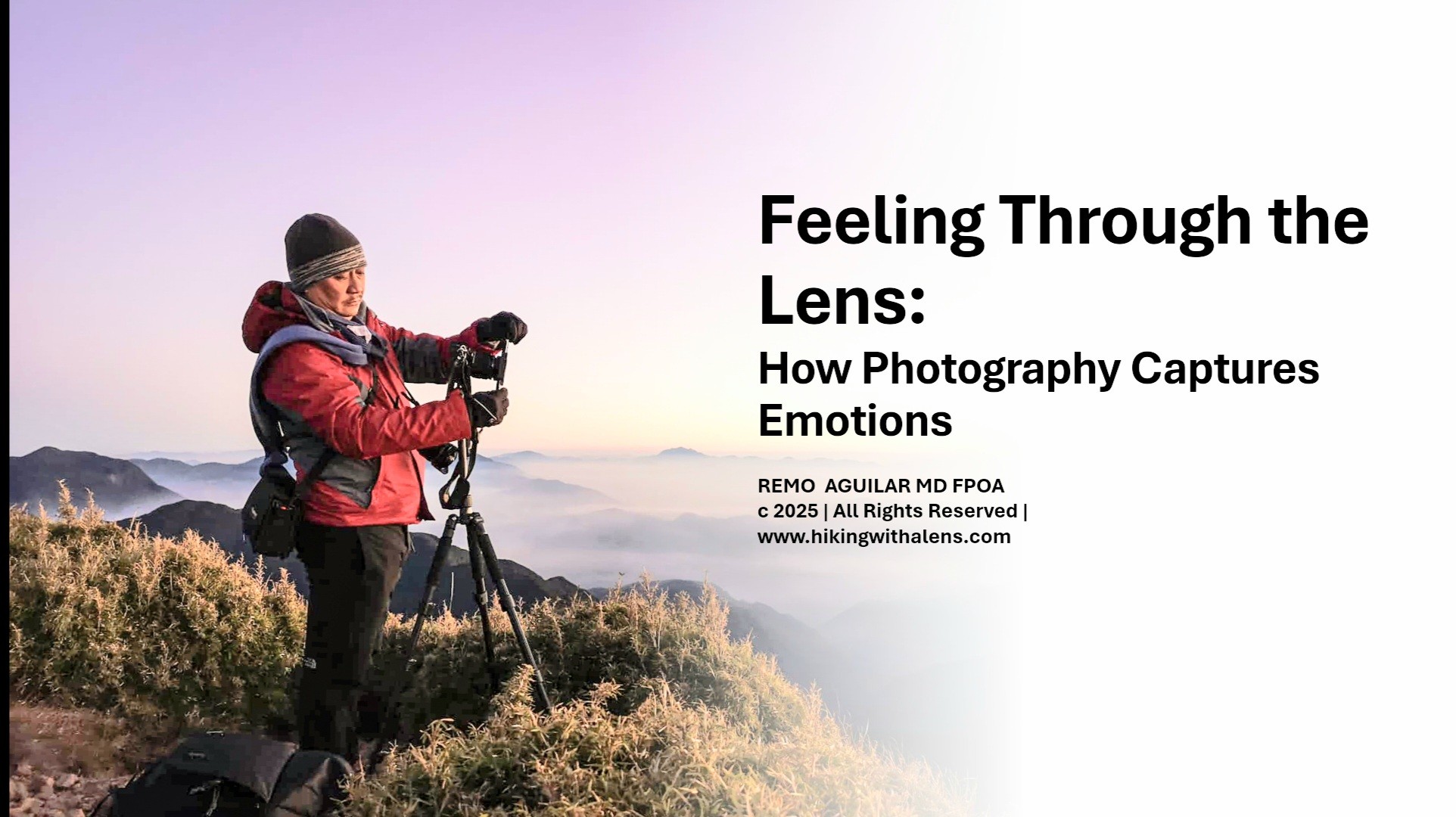Exploring the Therapeutic and Psychological Benefits of Photography
Introduction
“A picture is worth a thousand words, but can it also be worth a thousand moments of peace?”
Absolutely! Before I dive into the “how”, let me answer one question about this topic:
“I’m not a photographer. I couldn’t even take a decent photo using my mobile phone. Could I possibly take photos that are “worth a thousand moments of peace”?
Based on my experience, I have no doubt anyone can, and should take photos that gives ” a moment of peace”. Here’s my premise:
Photography serves as a tool for mindfulness, self-expression, and emotional healing, and thus play a significant role in one’s overall wellness.
That’s from a hobby, self-taught photographer, outdoors man and a orthopedists, who had 15 plus, playful years exploring photography and how it contributes to his mental, emotional and social experience.
So, in this Feb 15, 2025 version of #Healthxph chat, (hi yeah! We’re on Bluesky now!) let’s explore how photography contribute to one’s mental, emotional, and social well-being.
T1. Based on your experience, is there a connection between one’s wellness and photography?
Understanding Wellness and Its Connection to Photography
Definition of Wellness
World Health Organization (WHO) defines “wellness” as a holistic state of well-being encompassing physical, mental, and social aspects (WHO, 2022). Keyes (2002) highlighted the importance of creative expression in achieving wellness. Many of us in healthcare dabble in “creative expressions” outside (but often related to) our work, labelling these as “hobbies” unless its your primary source of putting food on your table. I’m a hobby photographer and my foremost excuse for doing so is creative expression. The habit of photography recharges me after working in a very stressful environment of healthcare.
Photography as a Therapeutic Medium
According to Gibson et al. (2018), photography combines creativity and mindfulness, promoting relaxation and self-awareness. Mindfulness involves focusing on the present moment with non-judgmental awareness. Photographers pay close attention to their surroundings, lighting, colors, and subjects. This process shifts attention away from stressors, helping individuals stay grounded in the present and reducing anxiety. This is very true for many of us in landscape photography, as we fully immerse in the changing light of sunsets/rise, the tides, background and foreground, the sky colors, clouds, among many things. We usually prepare and wait for hours, completely immersed in what we do, for at most, a window of 8-10 minutes for sunsets/rise in the Philippines.
I’m no psychiatrist or a psychologist but “Phototherapy”- the use of personal photographs, images, and photo-taking as a tool for psychological healing and self-exploration, a concept in clinical psychology pioneered by Weiser (2016) is very interesting. Phototherapy is a structured technique where photographs are used to trigger emotions, memories, and self-reflection, aiding in therapeutic conversations and interventions.
T2. Is there a psychological benefit to photography? Give examples.
The Psychological Benefits of Photography
Photography and Mindfulness
I’ve been a hobby photographer for over 15 years and started mindfulness practice for close to ten years. I don’t know if there is a relation or what triggered which among these, but I’m very sure there are moments when I’m completely immersed and focused on photography. My buddies (unlucky partners including) often tell me I’m a complete “snob and deaf ” when I’m shooting landscapes. I almost got hit by a passing truck while doing a “slow shutter photography” the side of a road. This is technically different from “Slow Photography” of Thomson (2020), which overall, emphasizes intentional, immersive, and mindful engagement with the photographic process . That may sound paradoxical to “living in the present moment”, but Williams et al (2018) posits photography as encouraging living in the moment and thus reduce stress and anxiety. Of course, not if you are hit by a speeding car in my case.
Photography as a Tool for Emotional Expression
Social media is loaded with photos serving as “tools” for emotional expression. Weiser (2016) stated that photos helps individuals process emotions and trauma through visual storytelling. Mine is much less of trauma but more on emotions- health, wellness, fun, excitement among other things. Note that my visual storytelling is often more of a “self-talk”.
Photography and Memory Enhancement
There are cognitive benefits to photography, if we are to believe Henkel (2014). In her study “Point-and-Shoot Memories: The Influence of Taking Photos on Memory”, she explores how photography can impact cognitive functions, particularly memory retention, recall accuracy, and perceptual awareness. The research examines both the positive and negative effects of taking photographs on memory and perception. My experience on this is mainly on portraiture and travel photography. Directing the angle, position of and lighting conditions of a model makes me remember more the shape of her face, the shades of light etc. Taking pictures of architectures and landmarks reminds me of its location, shape, significance and other nuances.
T3. What is the connection between photography and social or community wellness?
Social and Community Wellness through Photography
Photography and Social Connection
This is interesting. Let me focus on the “positive connections” between photography and community wellness. Negativity, in my opinion, predominate in many social media platforms. Chalfen (2020) mentioned that photography encourages engagement and shared experiences. Just look at the many social media communities sharing photos and videos. Many revolved around photos about the people and activities related to that community. The currency is the content which are commonly, photographs. My running and healthy lifestyle community have around 10-20 photo post in a day. Even in healthcare, engagement and connectedness is often thru photos shared by both patients and providers alike.
Photography in Expressing Cultural Identity and Empowerment
In many respect, a photographer often understand culture and identities through the photographic process. In my place, marginalized communities share their stories mostly through photographs (Azoulay, 2012). Capturing images of the cultural minorities made me more sensitive and thus became respectful of their practices and traditions.
Street, agricultural and landscape photography contest made me aware of the potential of photography for social change (Wang & Burris, 1997). Powerful images often highlights social concerns that have it not for this participatory photography (photowalks), no one would dare open their beyond their horizons.
Ecotherapy and Nature Photography
Bratman et al. (2019) explored the psychological and physiological benefits of “forest bathing”, also known as Shinrin-Yoku, a Japanese practice that involves immersing oneself in nature to reduce stress and enhance well-being. When combined with photography, this practice becomes an even more effective tool for mindfulness, relaxation, and emotional healing. When paired with photography, this experience encourages individuals to disconnect from digital stress and enter a state of calm and relaxation. I mentioned earlier that for many landscape photographers actively observe and capture natural details (e.g., leaves, flowing water, light patterns), often engaged in sensory awareness while framing shot for a long period of time.
T4. Give recommendations on how to use photography for wellness.
Practical Applications: How to Use Photography for Wellness
- Engaging in Daily Photography as a Mindfulness Practice
- Techniques: Photo journaling, gratitude photography, and “one-photo-a-day” projects.
- Using Photography in Therapy and Self-Care
- Photovoice technique in mental health interventions (Wang & Burris, 1997).
- Art therapy programs incorporating photography (Hagedorn, 2020).
- Encouraging Participation in Community Photography Projects
- Example: The Everyday Project and community-based storytelling (Everyday Africa, 2015).
Conclusion
- Summary: Photography is more than just an artistic hobby; it is a valuable tool for promoting mental, emotional, and social well-being.
- Let’s incorporate photography into our self-care routines.
- Closing Thought: “Wellness is a journey—why not capture it along the way?”
Don’t forget to join #Healthxph conversation on this topic, now on bluesky at February 15, 2025 9PM Manila time. See you all!
References
- Azoulay, A. (2012). The Civil Contract of Photography. Zone Books.
- Bohlmeijer, E. et al. (2021). “Photography in Reminiscence Therapy: A Cognitive Boost for the Elderly.” Journal of Aging Studies.
- Bratman, G. N., et al. (2019). “The Benefits of Nature Exposure on Mental Health.” Science Advances, 5(7).
- Chalfen, R. (2020). Snapshot Versions of Life: The Role of Photography in Society. Bowling Green State University.
- Fletcher, G., & Cambre, C. (2021). “Social Media Photography and Well-Being.” Journal of Digital Culture Studies.
- Gibson, R. et al. (2018). “The Therapeutic Effects of Photography.” Psychology of Aesthetics, Creativity, and the Arts, 12(4).
- Hagedorn, M. (2020). Photography and Art Therapy: A Creative Healing Practice. Routledge.
- Henkel, L. A. (2014). “Point-and-Shoot Memories: The Influence of Taking Photos on Memory.” Psychological Science, 25(2).
- Kaplan, R., & Kaplan, S. (1989). The Experience of Nature: A Psychological Perspective. Cambridge University Press.
- Smith, J., et al. (2019). “Photography as a PTSD Coping Mechanism Among Veterans.” Journal of Military Psychology, 32(1).
- Thompson, R. (2020). Slow Photography: Mindful Media Practices. Bloomsbury.
- Wang, C., & Burris, M. (1997). “Photovoice: Concept, Methodology, and Use in Participatory Needs Assessment.” Health Education & Behavior, 24(3).
- Weiser, J. (2016). Phototherapy Techniques: Exploring the Secrets of Personal Snapshots and Family Albums. Routledge.
- WHO (2022). “Wellness and Mental Health Promotion.” World Health Organization Report.
- Williams, A., et al. (2018). “Mindful Photography as a Psychological Intervention.” Journal of Positive Psychology, 13(5).





